Breaking Down Shane Waldron's Usage of Pre-Snap Motion, Fly Sweeps With Seahawks
With the Seahawks hiring a play-caller coming from a fashionable offensive coaching tree, those with interest in the team watched the preseason with excitement. What would Shane Waldron’s attack look like? How obvious would the Sean McVay influence be? Would every single offensive secret of Seattle's be revealed?
The reality of the preseason—a dwindling exercise of seemingly less and less importance—soon set in. While some cool elements, like the “strike” quick-hitting play-action concept, were on show, the lack of starters who participated in the exhibition games impacted the viewing experience.
A lot of the enthusiasm generated by the hire of Waldron was based around his presumed usage of pre-snap motion. The praise surrounding this subject is dangerously close to becoming an exhausted trope. Nevertheless, shifts and movement before plays will undoubtedly be a core tool of Waldron, regardless of the OC utilizing it less than expected in the preseason.
Why did we see little pre-snap motion in the preseason? Well, it makes sense that new concepts must first be learned and executed reliably by players, without much added pizzazz. Such window-dressing would risk complicating matters. Moreover, why would Waldron show anything particularly juicy in football that is fast losing meaning?
Motion was still present, though. One of the most evocative types Waldron will use is the “jet” or “fly” motion, where the receiver sprints rapidly across the field. We only saw six plays with fly motion attached to them (seven if you include one which came back with a holding penalty). You best believe we are going to study this sextuplet of flies.
After all, fly motion figures to be a major part of the layering in Waldron’s offense. This will be especially true in under center, where fly motion will act as a wide constraint for defenses that attacks the perimeter with speed. The offense will aim to make each play in the under center series look similar.
Defenders will play a torturous game of: "where’s the damn ball?!"
Has the ball been handed off to the receiver running the fly sweep? Has the ball been handed off in the other direction to the running back on outside zone? Has the ball been kept by the quarterback on a movement pass?
The offense, by maintaining the similar appearance, forces the defense to honor each part of the play. Defenders or defenses who cheat to a particular aspect better be right—and if they are, then that overplaying of a certain element can then be punished by the offense’s built-in, ready-to-go counter move. This is a footballing constraint.
We first saw John Ursua carry the fly sweep versus them Broncos in game two of the preseason. Then we enjoyed Dee Eskridge on the play in the third and final preseason fixture, in which Seattle called plays with fly motion versus the Chargers' defense five more times.
Not having the personnel suitable for the play is another reason for why we saw less of the fly sweep than we will in the regular season. In real football, Tyler Lockett will be on the field in addition to Eskridge. In March, I wrote an article featuring the "fly sweep guys” in the 2021 draft class because I knew a reliable fly sweep threat was a missing piece on Seattle’s roster. Eskridge, the Seahawks’ first selection, was included.
Fly No. 1
The Broncos were showing a two-high defensive structure midway through the first quarter. Seattle was in a gun doubles nub formation with pair tight ends to the boundary and the running back offset towards them. As Ursua motioned across, quarterback Alex McGough pop-passed the ball to him.
Right after this, McGough faked a wide zone read mesh-point with running back Alex Collins. Not only did this stress the defense horizontally in the other direction, it also held the unblocked defender, No. 45. This man was paused in conflict.

The pair of tight ends combo-blocked the force defender down at the line of scrimmage, using what McVay has called a “ZAP” technique. The inner most tight end, Cam Sutton, did a nice job securing the edge long enough for Ursua’s speed to get outside and cut upfield. Meanwhile, the outermost tight end, Dominick Wood-Anderson, climbed to the cornerback outside, almost on an arc path.
With Ursua cutting up the field, the high safety came down to make the tackle. The Seahawks netted an eight-yard gain.
Saturday also showed the #Seahawks' fly/jet sweep for the first time. They pop-passed it from the gun w/pair 12 personnel. Tough because OL shows hard wide zone one way while the TEs arc release-widen the other. ILB in conflict. Layers off this will be fun pic.twitter.com/ETKLRhYJmi
— Under Zone X (Frisco)/Phoenix Check/Stick Slasher2 (@mattyfbrown) August 27, 2021
Being able to successfully punish two-high safety shells in the run game, like this play, will be a major goal of Seattle's attack in 2021 after Pete Carroll spoke about the importance of this in his 2020 postseason debrief.
Fly No. 2
Close to the start of the fourth quarter, the Seahawks ran the exact same play. The Broncos were in a different front and they actually pressured on the play, although the key was that Denver remained in a two-high safety appearance pre-snap.
With Sean Mannion not being a running threat at quarterback, rather than execute a zone read fake post-pop pass he briefly put an imaginary ball in the belly of the running back and then dropped back at the mesh point.
To the fly sweep side, Sutton combo-blocked the force defender and then climbed to the corner. Wood-Anderson secured the force defender following Sutton’s help.
The unblocked linebacker over-pursued to the outside in his leverage. He may well have been influenced by Mannion’s mesh point work and a potential play-action, in which case the linebacker would have been responsible for covering the fly sweep down the field if it had turned into a wheel passing route.
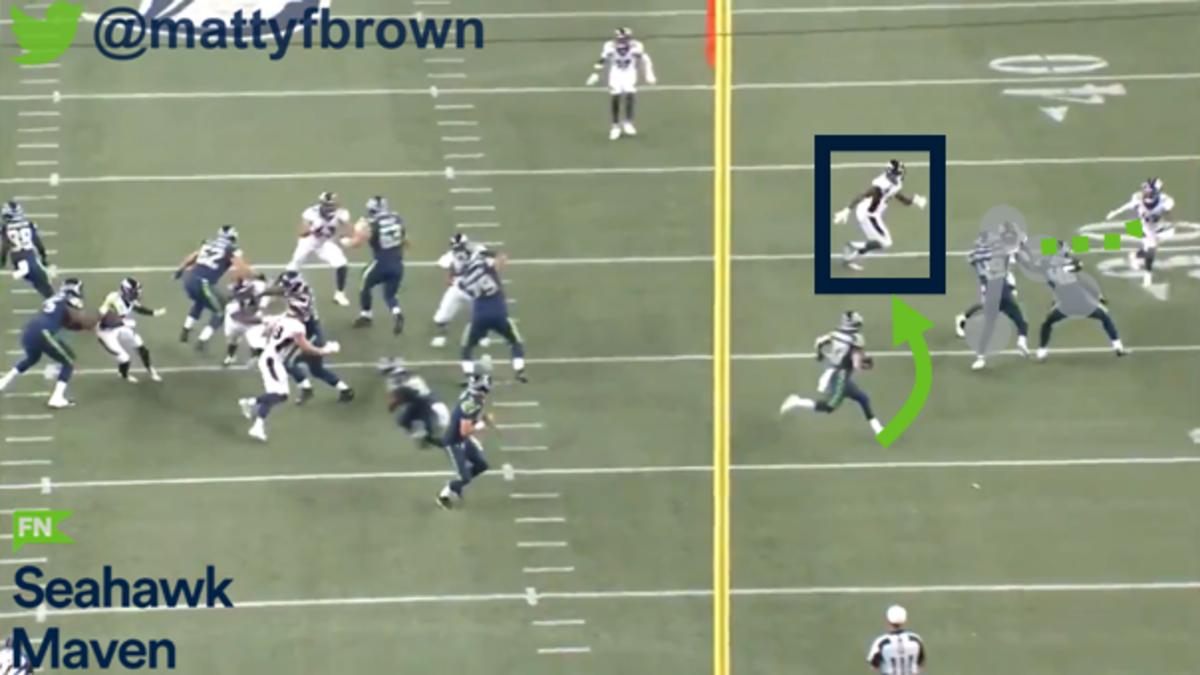
Connor Wedington read the blocks well on the fly sweep, but it was in a way that caused issues for Wood-Anderson. The cutback was there with the over-pursuit of the inside linebacker. However, the sharp, unexpected cut inside saw the blockers lose their leverage and Wood-Anderson was flagged for holding. The defender sold this one well. Really, this should have been 11 yards and a first down for the Seahawks.
Saturday also showed the #Seahawks' fly/jet sweep for the first time. They pop-passed it from the gun w/pair 12 personnel. Tough because OL shows hard wide zone one way while the TEs arc release-widen the other. ILB in conflict. Layers off this will be fun pic.twitter.com/ETKLRhYJmi
— Under Zone X (Frisco)/Phoenix Check/Stick Slasher2 (@mattyfbrown) August 27, 2021
Fly No. 3
The encounter with the Chargers provided us with what was essentially the under center version of the doubles, 12 personnel nub formation with the fly sweep. The quarterback at the mesh point, Geno Smith, handed to the fly sweep, then faked the wide zone handoff and the play-action pass/bootleg.
With the pre-snap presumed edge, force defender tightening down the line of scrimmage, the pair of tight ends left him unblocked and climbed to the force safety and cornerback. Will Dissly and Gerald Everett made solid contact with their men. Again, the unblocked inside linebacker was halted.
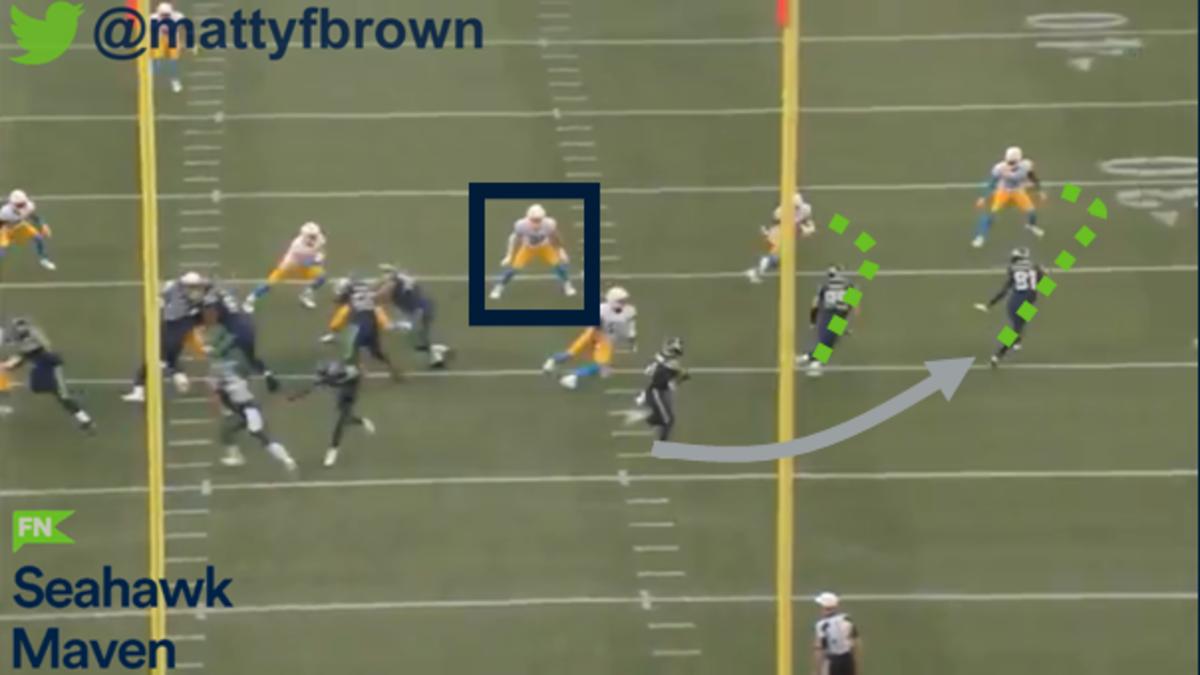
Running the fly, Dee Eskridge was almost overly patient on this play. Perhaps he is still adapting to NFL speed. Bursting to the outside and attacking the corner may have merited a larger gain on the play. You can see that Eskridge, altering his tempo as he so effectively does, wanted the gap in between Dissly and Everett.
Seattle still gained a first down plus more versus middle field closed, gapped-out defense.
— Ultra Rare Tape (@UltraRareTape) September 1, 2021
To the defense, the offense is essentially running two plays at once on this fly sweep. That’s why the offense can afford to leave the conflicted player unblocked. This man either has to pick between the two plays, which ends up leaving him static trying to process where the ball is. By the time this defender works out that the ball is with the fly sweep man, it’s too late for the defense. The tight ends are left free to focus on threats to the outside of them.
The pair, nub formation condenses and tightens the defense, creating more room for the fly sweep player to run into on the outside—even with the ball-carrier targeting the short side of the field. Additionally, the formation gives the tight ends a simple outside leverage track and friendly angles that simultaneously provide a simple read for the fly sweep man.
Fly No. 4
On the same drive and with 2:19 remaining in the first quarter, the Seahawks showed the same formation as the play above with the ball on the right hash. Yet on this occasion, Seattle handed the ball off to Alex Collins on a mid zone run.
On the frontside, Penny Hart’s cut split was tasked with blocking the force defender. The backside pair tight ends adjusted their behavior too. Dissly looked to scoop and help the backside tackle with a difficult reach block before climbing to the second level. And Everett looked to prevent any backside penetration, sealing the contain defender. You can see how easy this was made by the fly sweep occupying this edge.
The fly sweep also made the run-blocking angles for Seattle’s offensive line so much more friendly. Both linebackers fell back with the motion. One vacated the box entirely in favor of the fly sweep. The other fell back in such a manner that center Kyle Fuller was able to climb to him with a massive inside leverage advantage that resulted in a pancake.
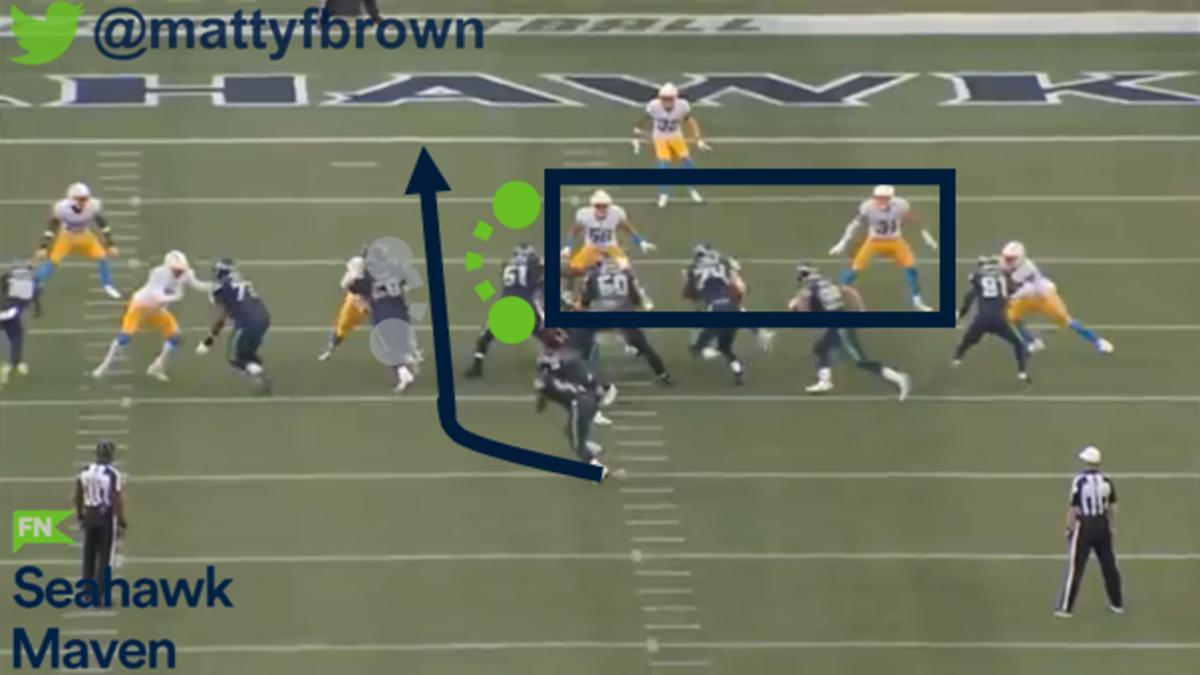
What allowed Fuller to do this was right guard Phil Haynes handling the movement of the nose tackle well and working off the natural help of right tackle Jake Curhan, eventually finishing inside-out with a semi pancake. Curhan beat his head up 4-technique defender to the spot, crashing into Haynes’ man and then mauling his own man down with Dissly’s help. Frontside, left guard Damien Lewis beat up his 3-technique and locked out to the right spot. Left tackle Jamarco Jones did enough on his kickout block.
Alex Collins picked up 10 yards and a new set of downs, running through a hole that was massive for the NFL. Three pancakes on a play will do that!
— Ultra Rare Tape (@UltraRareTape) September 1, 2021
It comes as little surprise how pumped Pete Carroll was afterwards:
When the #Seahawks run game hits pic.twitter.com/lCrUJvpfkT
— Under Zone X (Frisco)/Phoenix Check/Stick Slasher2 (@mattyfbrown) August 29, 2021
The formation aligning the run strength to one side and the pass strength to the other poses questions to a defensive play-caller, especially when the fly motion switches the passing strength to the same side as the run strength at the snap.
Fly No. 5
This was a creative redzone movement pass based off a fly sweep fake from the shotgun. It did not work. But that doesn’t remove the fun aspect. The Seahawks shifted from pistol 11 personnel 3x1 set to gun. Then Eskridge motioned over on the fly. Essentially, Seattle ran what would have been an unexpected play-action slide bootleg (based off the initial look) which put four receivers to one side of the pattern.
Smith saw Eskridge’s fly motion get followed by the slot defender with the Chargers in some kind of redzone matching coverage, looking to rotate their safeties around. Collins’ slide route into the flat looked to have the leverage advantage into a lot of space with a host of Los Angeles’ defenders caught inside.

Yet what looked like an easy touchdown did not play out that way. The Chargers defenders did well to avoid crashing into one another in the clogged traffic. Meanwhile, the timing of the play took too long and Smith’s throw was a bit funky, allowing the defenders to catch up and make a tackle for short gain.
— Ultra Rare Tape (@UltraRareTape) September 1, 2021
Fly No. 6
We also saw the Seahawks flex a 20 personnel fly sweep handoff via a power run fake and doubles formation. Both inside linebackers were occupied by the guard pulling frontside, removed from playing the outside run.

The playside tight end left the edge defender unblocked after he moved to the inside. This TE then secured the force defender. Penny on the fly sweep cut inside off this block for seven yards. The alley safety attacking hard downhill commanded the attention of the wide receiver at the point of attack.
— Ultra Rare Tape (@UltraRareTape) September 1, 2021
Fly No. 7
This was a different fly sweep layer to the shotgun on 1st and 19: a drop-back pass. The motion told the quarterback pre-snap that the defense was running a two-high zone coverage.
The fly also switched which side has three receivers on it. Before the motion: Seattle had three receiving threats to the wide side of the field. At the snap, the Seahawks flooded three receiving threats into the boundary. Notice how this pushed the Chargers’ middle linebacker to the three side and out of the high hole.
Ultimately, though, the post-wheel combination was covered well by the defense. Versus the open middle of the field, Smith wanted to target the post route once the cornerback passed it off to the safety inside. Yet the safety played the route with leverage and an aggressive, tight break that paused and eventually dissuaded Smith. The checkdown in the flat to the running back was available but Smith was hungry for the post.
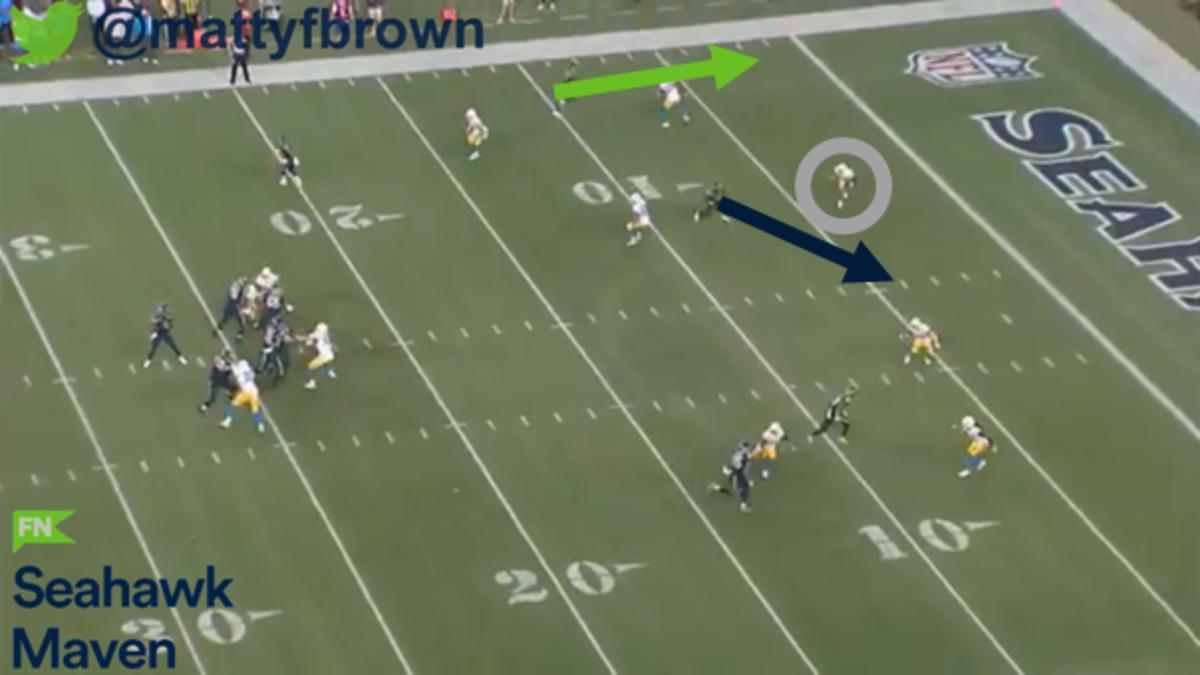
Smith somehow managed to move up in the pocket and escape for a big run. This was called back for a blindside block penalty on Penny that was not in the spirit of the rule.
— Ultra Rare Tape (@UltraRareTape) September 1, 2021
Real football
As we wait restlessly for the start of the NFL season and Seattle’s week 1 road trip to Indianapolis, the impatience only grows when imagining the other usages of fly motion the Seahawks are sure to use. Waldron’s attack with Russell Wilson at the helm should be a ton of viewing fun and the fly will deserve significant credit.
